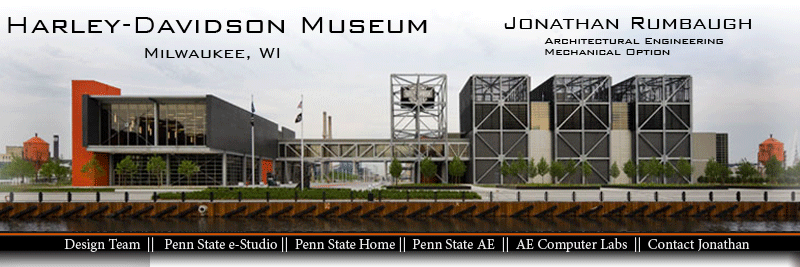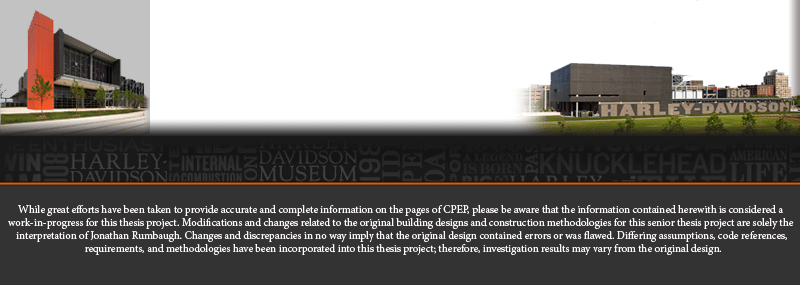 |
|||
 |
Download Proposal Here |
Depth Study: The design of the Harley-Davidson Museum's mechanical system achieves all design objectives and provides a healthy comfortable environment for all occupants. The redesign of the mechanical system will focus on reducing emissions and reducing energy consumption. The goal is to reduce the spread of contaminants that could be harmful to the environment, reduce operating cost as much as necessary to have a satisfactory rate of return, and to achieve sufficient LEED credits to enable the facility to become LEED certified. The proposed redesign is to replace the existing air-cooled chillers with a water-cooled system. An investigation into utilizing the adjacent Milwaukee river water for condensing water will also be conducted. Breadth 1: Electrical This electrical breadth will study the valued alternative of on-site combustion. Combined heat and power alternatives will be investigated. In this study electrical calculation will be conducted to properly size the fuel cell. Wire size and conduit selection will also be conducted on areas related directly to the fuel cell. An inverter will also need to be investigated to transform the DC power to AC. Breadth 2: Structural The structural system of the Harley-Davidson Museum presents many areas of thermal bridging through the exterior façade. Thermal bridging occurs when there is a conductive path between two separate zones at different temperatures. In the Harley-Davidson Museum there are many areas where thermal bridging is present. Many of the steel beams and several columns penetrate the exterior façade of the facility. The relatively high conductivity of steel permits heat to travel in and out of the building, this not only wastes energy, but can also cause condensation when the beam's temperature is below the dew point. When condensation forms there is a potential for corrosion, mold, and other indoor air quality problems. To combat these problems, the engineers at HGA utilized heat trace cable to heat the steel as it penetrates the façade when the outdoor temperature is below the point that would cause the steel's temperature to drop below the dew point. The proposed redesign to the thermal bridging concerns is to create structural thermal breaks in the steel framing where heat trace is used. An investigation of the structural properties of the break and the existing structural system loads will be investigates in this breadth study and a determination will be made as to if the structural breaks will support the structural loads and prevent thermal bridging. MAE Course Relation: The requirement for the Master of Architectural Engineering is to directly relate investigations to material studied in 500-level courses. AE 557, centralized Cooling Production and Distribution Systems will be related to the alternative design of the current air-cooled chiller. AE 551, Combined Heat and Power may be used in the investigation of fuel cells. AE 559, Computational Fluid Dynamics may be used to analyze the effects of thermal bridging. |
|
 |
|||
| This website was last updated on, Monday, January 30, 2012 11:18 AM - Website is hosted by the AE Department ©2011/2012 | |||